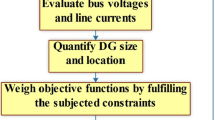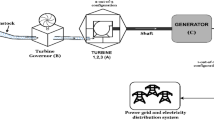Abstract
Load frequency control (LFC) plays an essential role in a power system (PS) to sustain the grid frequency for the period of sudden load demand variations. Hence, this manuscript deals with the execution of adaptive neuro fuzzy inference system (ANFIS) approach for LFC of three-area unequal thermal power system. The ANFIS controller proposed in the manuscript combines the advantages of Fuzzy Logic Control (FLC) as well as rapid response and flexible nature of artificial neural network. To improve the LFC performance, offered controller is simulated with superconducting magnetic energy storage (SMES) units and Thyristor controlled phase shifter (TCPS) individually and in combination. The performance of proposed ANFIS controller is superior and robust compared to existing control schemes and improved performance is observed particularly in the presence of SMES–TCPS combination. The realization of SMES & TCPS combination curtail frequency and tie power variation quickly after an unexpected load disturbance. To validate the usefulness of the proposed controller, integral time weighted absolute error (ITAE) and integral square error (ISE) performance error indices are used. Robustness of offered controller is demonstrated against wide variation in the system parameters.












Similar content being viewed by others
Abbreviations
- TAUTPS:
-
Three area unequal thermal power system
- ACE:
-
Area control error
- LDV:
-
Load demand variation
- ∆F:
-
Change in frequency
- ∆PTie-line :
-
Change in tie-line power
- i :
-
Subscript referring to area (i = 1, 2, 3)
- ∆P Mi :
-
Mechanical power input to power system
- ∆P Li :
-
Variations in load demand
- ∆P Gi :
-
Changes in governor power
- ∆Ptie,i :
-
Tie line power deviation in ith area
- H i :
-
Equivalent inertia constant of area i
- Tij :
-
Synchronizing coefficient for tie-line
- ∆f j :
-
Frequency deviations in jth control area
- R i :
-
Droop characteristics of area i
- β i :
-
Frequency bias constant of area i
- D i :
-
Equivalent damping constant of area i
- T Gi :
-
Time constant of governor for area i
- T Ti :
-
Time constant of turbine for area i
- a 12 :
-
Participation factor between ith and jth areas
References
Iracleous DP, Alexandridis AT (2005) A multi-task automatic generation control for power regulation. Electr Power Syst Res 73(3):275–285
Oysal Yusuf (2005) A comparative study of adaptive load frequency controller designs in a power system with dynamic neural network models. Energy Convers Manag 46(15–16):2656–2668
Talaq Jawad, Al-Basri Fadel (1999) Adaptive fuzzy gain scheduling for load frequency control. IEEE Trans Power Syst 14(1):145–150
Aravindan P, Sanavullah MY (2009) Fuzzy logic based automatic load frequency control of two area power system with GRC. Int J Comput Intell. 5:37–44
Khunti Swasti R, Panda Sidhartha (2012) Simulation study for automatic generation control of a multi-area power system by ANFIS approach. Appl Soft Comput J 12(1):333–341
Barisal AK (2015) Comparative performance analysis of teaching learning based optimization for automatic load frequency control of multi-source power systems. Int J Electr Power Energy Syst 66:67–77
Raju More, Saikia LC, Sinha N (2016) Department, “Automatic generation control of a multi-area system using ant lion optimizer algorithm based PID plus second order derivative controller”. Int J Electr Power Energy Syst 80:52–63
Dash Puja, Saikia LC, Sinha N (2014) Comparison of performances of several Cuckoo search algorithm based 2DOF controllers in AGC of multi-area thermal system. Int J Electr Power Energy Syst 55:429–436
Jagatheesan K, S. Samanta, A. Choudhury, N. Dey, B. Anand, A. S. Ashour (2018),Quantum inspired evolutionary algorithm in load frequency control of multi-area interconnected thermal power system with non-linearity. Quantum Comput Environ Intell Large Scale Real Appl 30:389–417
Dhillon SS, Lather JS, Marwaha S (2016) Multi objective load frequency control using hybrid bacterial foraging and particle swarm optimized PI controller. Int J Electr Power Energy Syst 79:196–209
Rajbongshi R, Saikia LC (2017) Performance of coordinated FACTS and energy storage devices in combined multiarea ALFC and AVR system. J Renew Sustain Energy 9(6):064101
Mitani Y, Tsuji K, Murakami Y (1988) Application of superconducting magnetic energy storage to improve power system dynamic performance. IEEE Trans Power Syst 3:1418–1425
Tripathy SC, Juengst KP (1997) Sampled data automatic generation control with superconducting magnetic energy storage in power systems. IEEE Trans Energy Convers 12(2):187–192
Sudha KR, Santhi RV (2012) Load frequency control of an interconnected reheat thermal system using Type-2 fuzzy system including SMES units. Int J Electr Power Energy Syst 43(1):1383–1392
Aditya SK, Das D (2001) Battery energy storage for load frequency control of an interconnected power system. Electr Power Energy Syst Res 58:179–185
Dhundhara S, Verma YP (2018) Capacitive energy storage with optimized controller for frequency regulation in realistic multisource deregulated power system. Energy 147:1108–1128
Hingorani NG, Gyugyi L (2000) Understanding FACTS : concepts and technology of flexible AC transmission systems. Wiley-IEEE Press, New York
Deepak M, Abraham RJ (2015) Electrical power and energy systems load following in a deregulated power system with Thyristor controlled series compensator. Int J Electr Power Energy Syst 65:136–145
Reddy K, Reddy S, Padhy NP, Patel RN (2006) Congestion management in deregulated power system using FACTS devices. In: 2006 IEEE Power India Conf., pp 376–383, 2006
Menniti D, Pinnarelli A, Scordino N, Sorrentino N (2004) Using a FACTS device controlled by a decentralised control law to damp the transient frequency deviation in a deregulated electric power system. Electr Power Syst Res 72(3):289–298
Bhatt P, Roy R, Ghoshal SP (2011) Comparative performance evaluation of SMES–SMES, TCPS–SMES and SSSC–SMES controllers in automatic generation control for a two-area hydro-hydro system. Int J Electr Power Energy Syst 33:1585–1597
Dahiya P, Sharma V, Naresh R (2017) Optimal sliding mode control for frequency regulation in deregulated power systems with DFIG-based wind turbine and TCSC–SMES. Neural Comput Appl 1–18. https://doi.org/10.1007/s00521-017-3250-y
Bevrani H (2009) Robust power system frequency control. Springer, New York, US
Pappachen A, Fathima AP (2016) Load frequency control in deregulated power system integrated with SMES–TCPS combination using ANFIS controller. Int J Electr Power Energy Syst 82:519–534
Abraham RJ, Das D, Patra A (2007) Effect of TCPS on oscillations in tie-power and area frequencies in an interconnected hydrothermal power system. IET Gener Transm Distrib 1(4):632–639
Tripathy SC, Balasubramanian R, Nair PSC (1992) Adaptive automatoc generation control with superconducting magnetic energy in power systems. IEEE Trans Energy Convers 7(3):434–441
Zadeh L (1965) Fuzzy sets. Inf Control 8(3):338–353
Mendel JM, Mouzouris GC (1997) Designing fuzzy logic systems. IEEE Trans. Circ Syst II Analog Digit Signal Process 44(11):885–895
Yin X, Lin Y, Li W, Liu H, Gu Y (2015) Fuzzy-logic sliding-mode control strategy for extracting maximum wind power. IEEE Trans Energy Convers 30(4):1–12
Yin X, Lin Y, Li W, Gu Y, Liu H, Lei P (2015) A novel fuzzy integral sliding mode current control strategy for maximizing wind power extraction and eliminating voltage harmonics. Energy 85:677–686
Yin X, Lin Y, Li W, Gu Y, Lei P, Liu H (2015) Sliding mode voltage control strategy for capturing maximum wind energy based on fuzzy logic control. Int J Electr Power Energy Syst 70:45–51
Yin X, Lin Y, Li W, Liu H, Gu Y (2014) Output power control for hydro-viscous transmission based continuously variable speed wind turbine. Renew Energy 72:395–405
Yin X, Lin Y, Li W, Gu Y (2014) Integrated pitch control for wind turbine based on a novel pitch control system. J Renew Sustain Energy 6(4):043106
Prakash S, Sinha SK (2014) Simulation based neuro-fuzzy hybrid intelligent PI control approach in four-area load frequency control of interconnected power system. Appl Soft Comput J 23:152–164
Jang J-SR (1993) ANFIS: adaptive-network-based fuzzy inference system. IEEE Trans Syst Man Cybern. 23(3):665–685
Rojas I, Bernier JL, Rodriguez-Alvarez R, Prieto Z (2000)What are the main functional blocks involved in the design of adaptive neuro-fuzzy inference systems? In: Proceedings of the IEEE-INNS-enns international joint conference on neural networks. neural computing: new challenges and perspectives for the new millennium, vol. 6, pp 551–556, 2000
Abdelrahim EM, Yahagi T (2001) A new transformed input-domain ANFIS for highly nonlinear system modeling and prediction. In: IEICE transactions on fundamentals of electronics, communications and computer sciences, vol. E84–A, no. 8. IEEE, Toronto, Ontario, Canada, pp 1981–1985, 2001.
Prakash S, Sinha SK (2017) Automatic load frequency control of six areas’ hybrid multi-generation power systems using neuro-fuzzy intelligent controller. IETE J Res 2063:1–11
Acknowledgements
This work is supported by Electrical and Instrumentation Engineering Department, Thapar University, Patiala, Punjab and Electrical Engineering Department, Guru Kashi University, Bathinda, Punjab.
Author information
Authors and Affiliations
Corresponding author
Rights and permissions
About this article
Cite this article
Sharma, M., Bansal, R.K. & Prakash, S. Robustness Analysis of LFC for Multi Area Power System integrated with SMES–TCPS by Artificial Intelligent Technique. J. Electr. Eng. Technol. 14, 97–110 (2019). https://doi.org/10.1007/s42835-018-00035-3
Received:
Revised:
Accepted:
Published:
Issue Date:
DOI: https://doi.org/10.1007/s42835-018-00035-3




